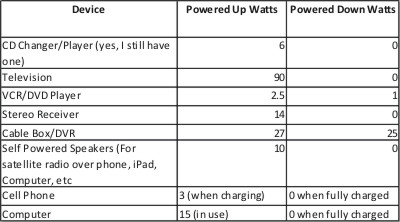
The day after last week’s election, the headlines included discussions about the “fiscal cliff” coming on January 1, 2013, when the “Bush” tax cuts expire and substantial automatic spending cuts kick in. I guarantee this will not come and go without high drama. First thing after the election comes the ceremonial token olive branches, and five minutes later both sides return to sharpening their heals and digging in.
I would say energy efficiency has it’s own version of the fiscal cliff coming, and that is the end of the gravy train – lighting retrofits – the so-called low hanging fruit, a term I adore as much as the end of the day. Actually, it will be more of a descent into Death Valley as mandates phase out old-fashioned T12 and incandescent light bulbs. So what is the solution to the Death Valley Spiral? Vampire loads! This I read recently on a blog post or email. Going after vampire loads would be like making car radios use less power to improve gas mileage. Vampire loads don’t amount to squat, and I mentioned this in a blog a long time ago, but I just reran my own home tests.

First, what is a vampire load – energy consumed when a device is turned off. Leaving things on – like stereo and home entertainment equipment is not a vampire load. Here is my vampire load study:
The cable box DVR takes about 15 minutes to boot up, and it seems to not really have a power off mode, but if one likes to wait 15 minutes three times a day to save $20 in a year, go for it. Granted, this could certainly come with better not-in-use power characteristics. Nevertheless, this IS NOT a phantom/vampire load anyway. The VCR/DVD player burns a stunning 1 Watt, most likely to burn the digital clock on the display.
What is one frontier you never read or hear about? Stupid use of expensive fuel, and the most expensive fuel is electricity. If the country wants to take giant steps toward reducing energy consumption, why not promote fuel switching from dumb uses of electricity to natural gas wherever possible.
Last March or so, I bought a retractable clothesline for $12.95 at Menards. Simple payback: about 7.5 weeks (5kW, half hour per load, load per day, 10 cents/kWh). With the deck and clothesline on the north side of the house and winter coming, the “efficiency” of the clothesline is not so grand, so I’m staring at my 5 kW electric dryer.
Why do I have an electric dryer? Because in the La Crosse area, the standard apartment lease comes with “hookups” for washer and dryer but no washer and dryer. So, the hookups of course include electric-only energy sources for clothes dryers. Our choice, therefore, when moving here was electric dryer or the thrill of the Laundromat.
These hookups without appliances are as commonsensical as the Wisconsin bubbler.[1] Tenants have to buy and lug washers and dryers from place to place? Why not refrigerators and stoves too?
The mom and pop stores around here, where I prefer to shop because service to me is king, do not even carry gas dryers. Electric water heaters are another travesty. Using electricity to dry clothes and heat water is the same as buying a Husqvarna 5kW generator that burns gasoline to make toast in the morning.
In a triple or quadruple irony, it reminds me of the Nissan Leaf commercial. Speaking of double ironies, you have to sit through an ad to watch the Leaf ad on YouTube. Electricity is actually a smart fuel for cars, just as wind is for power generation, but there are about 46 physical limitations and barriers for making it a decent full blown alternative to liquid or gaseous fueled transportation.
Some barriers to smart fuel switching include old school energy program thought. Without an exhaustive investigation, I am not aware of any programs that provide incentives to switch from expensive, and from a resource perspective, more wasteful electricity to less expensive natural gas.
The fuel switching is a matter of cross-subsidization where, for example, an electric customer gets a rebate from the electric utility for switching to natural gas. The electric rate payers are benefiting the gas customers. If you stop and think about this a little bit, it is entirely foolish. When the electric utility throws money at a customer for installing more efficient lighting, it benefits the light bulb manufacturers – in CHINA! What is the difference to the electric rate payers OR the electric utility? Electric rate payer money via EE programs is used to reduce demand and sales of electricity while benefiting others customers and other retail sellers of stuff. What difference does it make whether the stuff is light bulbs, insulation, windows, automatic controls, or natural gas?
And consider this, nearly all the new electrical generating capacity is produced by natural gas. We pay to build natural gas plants, poles and wires to produce electricity at perhaps 70% efficiency (roughly for combined cycle plants) to power water heaters, clothes dryers, stoves and other stuff. Therefore, we use more natural gas, not less. As a result, we require more infrastructure for both natural gas and electricity delivery.
Not promoting fuel switching costs consumers at every turn. What is the problem here? Figure it out. Let’s go.
[1] Not knowing what a bubbler is is about as shameful as not knowing the name of a character on an HBO drama series, or the third string center for the Packers – from the 1988 squad.





